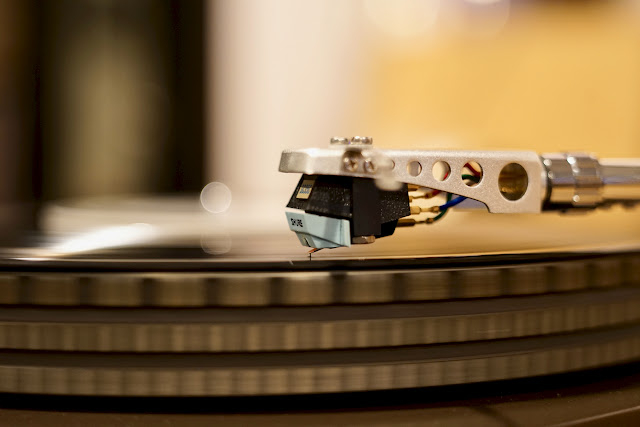Altec 755A in an Open Baffle
My adventure into high-efficiency speakers started with a pair of Altec 755Cs (and later, 755As) mounted on this very same open baffle. It was easy for me to appreciate the lack of boxy coloration, having lived with Quad ESLs for a couple of years.
Dr. Bae/Silbatone Box + Altec 755A
Altec 755A + Altec 618
[2 cubic foot sealed box]
 |
| A pair of Altec 618 cabinets |
 |
| Altec 755A in the 618 box |
The Altec 618 box is now loaded with 755Cs and has great synergy with the JLH 1969 clone amp.
Altec 753C
 |
| Altec 414A in the ported 753C cabinet |
 |
| Altec 414A |
My straightforward explanation: A:27.5 Hz played on an upright piano will produce less intensity as a fundamental note compared to that from a nine-foot concert grand because the instrument is physically smaller and the length of string, shorter. However, that upright piano's A:27.5 Hz is still perceived as A:27.5 Hz by the human ear, albeit less visceral, because of the harmonic overtones produced.
 | |
|
Sound Practices
Simple Crossover
 |
| Altec 753C crossover using paper in oil capacitors + Mills non-inductive resistors schematic |
I've found the RTA to be helpful in adjusting crossover points with the help of a crossover calculator. A simple example: if the sound is harsh, move the crossover point higher. If you need more bite or presence, go lower.
Altec 414A + 32C horn + 802D compression driver
+
JP 753C ported cabinet = Altec 753C
Driven by 3500 milliwatts per channel of SE-DHT power, these speakers allow me to enjoy Mahler symphonies in my man cave with nuanced macro and micro dynamic contrasts. It gives a middle of the hall presentation which is my preferred perspective. The midrange is warm and coherent with a nice three dimensional quality.
Even if the extreme lows are curtailed, the harmonic overtones produced in this frequency region have enough foundation for big orchestral works. There's a wispy ribbon-like airiness in the extreme top which, to my ears, no longer need help from my pair of Altec 3000H super tweeters.
I probably could've gotten another half octave of bass extension if I chose the 15" Altec 416A woofer, but then I would've run into problems blending it with the 32C/802D horn/driver using a simple crossover. Even if I succeeded in EQ'ing out the peaks of the 416A, efficiency and midrange coherence would've suffered.
Everything is a compromise and I believe I've chosen wisely.
Driven by 3500 milliwatts per channel of SE-DHT power, these speakers allow me to enjoy Mahler symphonies in my man cave with nuanced macro and micro dynamic contrasts. It gives a middle of the hall presentation which is my preferred perspective. The midrange is warm and coherent with a nice three dimensional quality.
Even if the extreme lows are curtailed, the harmonic overtones produced in this frequency region have enough foundation for big orchestral works. There's a wispy ribbon-like airiness in the extreme top which, to my ears, no longer need help from my pair of Altec 3000H super tweeters.
I probably could've gotten another half octave of bass extension if I chose the 15" Altec 416A woofer, but then I would've run into problems blending it with the 32C/802D horn/driver using a simple crossover. Even if I succeeded in EQ'ing out the peaks of the 416A, efficiency and midrange coherence would've suffered.
Everything is a compromise and I believe I've chosen wisely.
Wanted: smooth sounding 12"-15" wide range driver + horn + compression driver
Although Great Plains Audio is still manufacturing the 414 and 802 drivers with alnico magnets, IMHO, the listed prices are too steep to even attract the attention of the DIY community or smaller boutique manufacturers.
I've used and highly recommend their replacement aluminum diaphragms for 1" format compression drivers. I've been told that the GPA 414 doesn't sound like the classic 414A/Z/8B/16B and is 3dB less efficient. However, I don't have hands-on experience with the GPA drivers to confirm any of those claims.
GPA is our only direct connection to the past when transducers were designed using human ears aided by measurement tools. For that alone, I want them to succeed!
Radiotron, 3rd Edition Redux
Wanted: smooth sounding 12"-15" wide range driver + horn + compression driver
I've used and highly recommend their replacement aluminum diaphragms for 1" format compression drivers. I've been told that the GPA 414 doesn't sound like the classic 414A/Z/8B/16B and is 3dB less efficient. However, I don't have hands-on experience with the GPA drivers to confirm any of those claims.
GPA is our only direct connection to the past when transducers were designed using human ears aided by measurement tools. For that alone, I want them to succeed!









































